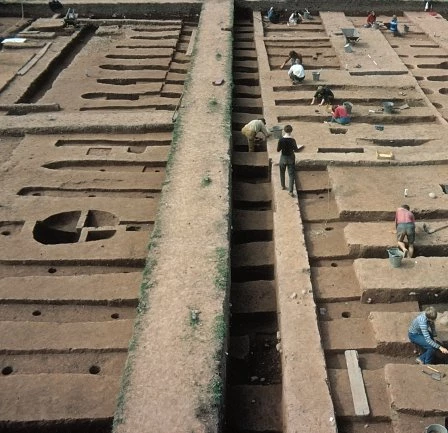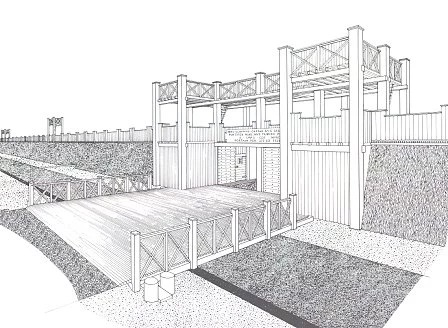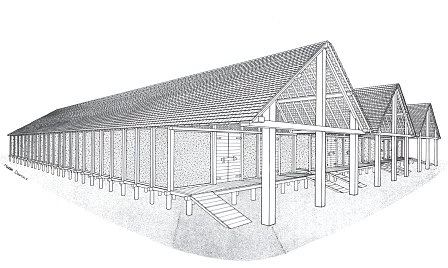Roman fortress discovered underneath town centre
Excavation of the granaries at Usk. The horizontal lines running across the image are the foundations for the timber granaries, with the holes for vertical posts visible in the base. A later pit can be seen cutting through one of the foundations trenches on the left-hand side. The vertical lines are unexcavated areas.
Reconstruction of the East Gate, Usk (by Martin Dugdale). Built of timber, as was all the fort, it consisted of twin towers flanking a double carriageway, linked by a walkway above the road.
Reconstruction of the three large granaries at Usk (by Martin Dugdale). The floors of these buildings were raised clear above the ground to prevent damp and vermin reaching the grain and other food stored inside.
Finds from the excavations at Usk are housed at the National Roman Legion Museum at Caerleon.
Excavations in the town of Usk, South Wales in the 1960’s, revealed a fortress that was once home to Rome's Twentieth Legion.
William Camden (1551-1623) was the first to record a link between the Romans and Usk (Monmouthshire) - identifying it as the site of Burrium. However it was not until the late 1960s that an early legionary fortress was discovered beneath the southern half of the town.
It was built in about AD55, probably by the Twentieth Legion, as a base for the conquest of south Wales.
The fortress covered an area of 19.5ha (48 acres) and was defended by an outer V-shaped ditch, and a clay and turf rampart faced with timber. This had a walkway on top, wooden towers at intervals and a gateway on each side.
Granaries and cavalry regiments
Large-scale excavations between 1965 and 1976 revealed two groups of granaries - used to store the provisions necessary to feed the large invasion force - a workshop and part of an officer's house, all built of wood. More recent work suggests that an auxiliary cavalry regiment (known as an ala) may also have been stationed with the legion.
Reorganization of the Roman army in AD66 or 67 saw the transfer of the Twentieth Legion from Usk to Wroxeter (Shropshire). This move established a line of fortresses running north-east from Exeter to Lincoln and rendered Usk obsolete as a fortress.
A new legionary fortress
However, Usk continued to be held by a small 'caretaker' garrison until AD74-75 when a new legionary fortress was established eight miles downstream at Caerleon (Newport) - a location which was less liable to flooding and was easier to supply by sea. Even then, Usk was not completely abandoned by the Romans, who established a small auxiliary fort/works depot on the site. This fort did not last beyond the end of the 1st century AD, but the works depot appears to have had a much longer life.
Today nothing survives of the fortress above ground to indicate the part this small town played in the conquest of Wales. The fortress was systematically demolished by the Romans and any timbers left have long since rotted away.
Background Reading
Report on the Excavations at Usk 1965-1976: The Fortress Excavations 1968-71 by W. H. Manning. University of Wales Press (1981).
Report on the Excavations at Usk 1965-1976: The Fortress Excavations 1972-74 and Minor Excavations on the Fortress and Flavian Fort by W. H. Manning. University of Wales Press (1989).




Comments - (3)
How can I get a good print.
It was a fantastic dig.We were just behind the correctional institution.Pam Quennel was assistant site coordinator as I remember.Many students lived on the site from all over the world.We had great times around campfires and at the local(was it the Red Lion?)
I remember the head at the site was Chris whose surname illudes me he was from Cardiff Uni but lived in High Wycombe.
We were paid 30s per week with meals and Friday off so we would bundle down to Bath or Cardiff or Newport.
Fantastic times.
Andrew
Unfortunately there are no remain of the fortress above ground. The fortress was systematically demolished by the Romans and any timbers left have long since rotted away.